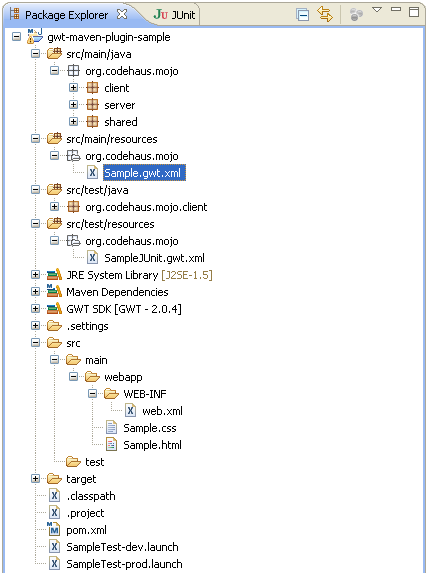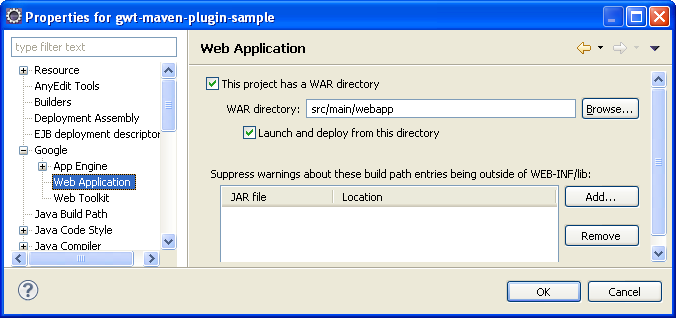Project organization
Conventions
Compared to GWT Documentation on directory layout, the plugin follows Maven conventions:

Compared to the directory layout used by GWT, notice that the /war folder is replaced by the src/main/webapp folder, following maven-war-plugin conventions. The project structure generated by the gwt-maven-plugin archetype allready includes the adequate Google Plugin for Eclipse configuration. If you manually migrate a GWT project to Maven, you will need to configure the Google Plugin for Eclipse to use this folder.

POM configuration
In order to use gwt-maven-plugin, you will need to configure it using the plugins section of your POM.
You also need to include the GWT dependencies in your POM, and use the adequate gwt-maven-plugin version. The plugin will check this version and warn if you try to use inconsistent releases.
<dependencies>
<dependency>
<groupId>com.google.gwt</groupId>
<artifactId>gwt-servlet</artifactId>
<version>2.8.1</version>
<scope>runtime</scope>
</dependency>
<dependency>
<groupId>com.google.gwt</groupId>
<artifactId>gwt-user</artifactId>
<version>2.8.1</version>
<scope>provided</scope>
</dependency>
<dependencies>
<build>
<plugins>
<plugin>
<groupId>org.codehaus.mojo</groupId>
<artifactId>gwt-maven-plugin</artifactId>
<version>2.8.1</version>
<executions>
<execution>
<goals>
<goal>compile</goal>
<goal>generateAsync</goal>
<goal>test</goal>
</goals>
</execution>
</executions>
</plugin>
</plugins>
</build>Note : Don't define gwt-dev as project dependency : this JAR only contains gwt SDK tools and has many common libraries packaged that may conflict with the ones defined for your project, resulting in uncomprehensible NoSuchMethodErrors. The gwt-maven-plugin will automagically resolve the required dependency and add it to classpath when lauching GWT tools.
Multi-project setup
Large Maven projects often are divided into sub-projects. This section describe the maven configuration needed to use such layout on GWT projects with gwt-maven-plugin. If you're not familiar with multi-module layout, please read first the related maven documentation.
NOTE that GWT also has a notion of module. Both Maven and GWT use the term module to define units of modularization. To a degree both concepts go hand in hand, as gwt-modules define boundaries at which Maven-modules might be cut. To not confuse these two terms though, for the rest of this section we will use the term module, if we talk about GWT-modules, in contrast to the term project, if we talk about Maven-modules.
First, we will setup a basic Maven project structure consisting of two sub-projects: one containing domain code and another one containing the actual GWT application. Like other web application, a common pattern is to separate GUI functionality from domain functionality (among others) :
parent/ (aggregating parent project)
|- pom.xml
|
|- domain/ (domain code, etc.; packaging: JAR)
| |- pom.xml
| \- src/main/java/
| \- org/codehaus/mojo/domain
| \- User.java
|
\- webapp/ (GUI code; packaging: WAR)
|- pom.xml
\- src/
|- main/java/
| \ -org/codehaus/mojo/ui/
| |- Hello.gwt.xml
| \- client/Hello.java
\- main/webapp/
\- WEB-INF/web.xmlTo convert the domain project to a valid GWT module, we add a module descriptor Domain.gwt.xml to the domain project that we can extend from our webapp Hello module.
|- domain/ | |- pom.xml | \- src/main/java/ | \- org/codehaus/mojo/domain/ | \- User.java | \- src/main/resources/ | \- org/codehaus/mojo/ | \- Domain.gwt.xml (Additionnal gwt.xml module file)
<module> <inherits name="com.google.gwt.user.User"/> <source path="domain"/> </module>
The domain project is not yet a valid GWT module: GWT compiler requires Java source files.
Configure Maven to package a sources JAR for domain project. In the webapp project, add a dependency to the ''sources JAR'' package:
<dependencies>
<dependency>
<groupId>com.mycompany</groupId>
<artifactId>domain</artifactId>
<version>${project.version}</version>
<classifier>sources</classifier>
<scope>provided</scope>
</dependency>
</dependencies>


